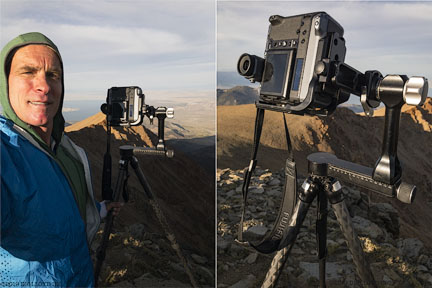Reader Comment/Question: Image Stabilization and Sharpness, Monopod vs Tripod
Years ago, I did extensive research on tripods, evaluating many models and different size and weights. In a nutshell, resonance is the key factor and it correlates only moderately with tripod weight—I fund some heavier tripods had more resonance!
Ben R writes:
Good morning, I'm a subscriber to Diglloyd.
I'm a landscape photographer based in the UK, but perhaps unusually, instead of using wide angle lenses, I prefer using a combination of longer lenses and stitching for my large - 10 ft wide - prints.
For a couple of years I've been mainly using a Canon 5DSR and the very sharp 200mm f2, but when it became available I upgraded to a Fuji GFX100 and their 100-200mm.
I've always believed that all forms of IBIS and lens stabilization when mounted onto a tripod make for an unhappy marriage, so when I read about your experience with IBIS and long exposures I was not at all surprised.
Your conclusion was to avoid using IBIS on a tripod at very long exposures, but you made no comment on short-ish exposures, those between 1/8 and 1/125.
Like you, many of my photographs are taken in low light, and carrying a heavy tripod on location is not always practical, (In my experience lightweight tripods and heavy cameras create more problems than they solve).
I have been testing using a lightweight monopod and Fuji IBIS (using the heavy 100-200mm lens) as a compromise.
I try and shoot at 200mm (I'll buy the 250mm lens when I can afford it) at exposures between 1/8 and 1/125.
So my query: as a monopod can dampen - but not eliminate - user motion, the argument of whether or not to use IBIS with a monopod is unclear. My tests indicate that it should be a positive technique, but it's not conclusive. Do you have a view that you can share with me, and perhaps other followers of Diglloyd?
DIGLLOYD: my work over the past few years suggests that image stabilization on a tripod at intermediate speeds mentioned above can be effective, but frequently delivers damaged sharpness also, often worse than not using it (though subjectively different in results). But when image stabilization works, it can in some cases produce superior results to not using it, the trick being to take 3 or 4 exposures.
Recently I shot the Fujifilm GF 250mm f/4 in windy conditions on a sturdy tripod. It has the usual and typical awful lens foot teeter-totter design. Enabling image stabilization was LESS effective than shooting several frames in succession, judiciously timing the exposure. Best technique: use a wireless release with the lens view at 100% Live View and hit the remote release button when it settles momentarily; this works wonders like you would not believe—far, far better than image stabilization. Do this 3 or 4 times and you can usually get a tack-sharp image down to half a second or so. Unfortunately, I do not have a wireless remote with me.
An ultralight tripod and a heavy camera can work and I have used that very successfully. So long as full electronic shutter is used and the ground is stable, tack sharp images can result. But ultralight tripods have increased leg resonance (wind) and are top heavy and require extra care as well as being far too low in height far too often. This is why my minimum tripod barring extreme weight needs is the Really Right Stuff TFC-24L.
Furthermore, the teeter-totter effect of modern lens tripod feet is a stability disaster, worse than any other aspect of the support system by an order of magnitude—you can see in real time in 100% Live View by just puffing on the lens with your breath (say a 300mm on up). Resonance waves cycle through the lens back and forth and wavefronts peak as new inputs occur (e.g., wind).
Monopod
A monopod in my experience is good for easing the physical load but not for reliable sharpness versus proper handheld technique. Though a monopod might be better in a single axis for stability (up/down), this is of little real value in practice in my experience (versus my mass coupling technique). It also seems particularly awkward to use my mass coupling technique with a monopod, but maybe some could make that combo work.
My experience tells me that my “mass coupling” hand-holding technique will be superior to a monopod most of the time. That’s because it reduces movement in all axes, and reduces those movements to gross ones (low frequency), especially in wind conditions. Combine it with image stabilization and this is generally a big plus; something about that combination is more predictable the image stabilization system, resulting in a higher hit rate.

(Really Right Stuff PG-02 on the Really Right Stuff TFC-24L Tripod)
iPhone 7 Plus + iPhone 7 Plus 4.0 mm f/1.8 @ 28mm equiv (4mm)
ENV: Dana Plateau, altitude 12500 ft / 3810 m, 55°F / 12°C
[low-res image for bot]
Reader Paul B forwarded some comments; Andy Goris writes:
These guys in-the-field experience trumps my lab testing in my yard and garage, but several things I learned, which agree with the points here:
1. On long telephotos, IS on a tripod can help for faster (<1/10 sec) exposures. Definitely take multiple pictures if you can. A better answer is an electronic shutter. I don’t think we’re to the point that electronic shutters are as good as mechanical - they still have some light leak - but, as the Beatles sung “it’s getting better all the time”.
2. For IS to work on a tripod, the feet MUST BE STABLE. This means rubber feet on concrete or wood floor, or spiked feet in dirt or grass. Otherwise, if the IS is moving any mass at all it can get in to a resonance with the tripod - IS moves lens, lens slightly moves tripod, IS now has to compensate for tripod motion, etc. This doesn’t happen hand-held because of your mushy skin.
3. Don't use IS for stacked photos (HDR) on a tripod if you’re trying to have all the frames the same. IS moves the framing a noticeable amount.
DIGLLOYD: seems about right.
I would add that I use electronic shutter much of the time, if only to avoid potential shutter shake in risky situations (like 250mm lenses shot at intermediate shutter speeds). Whatever the flaws of an electronic shutter use in the f/4 to f/11 range in my testing on Sony could show no difference in outdoor conditions as to bokeh (it does matter for for f/1.2 and f/1.4 and a bit at f/2).
As to HDR, see my work on frame averaging—IMO frame averaging solves the problem better and faster for some cameras with appropriate freatures—in most outdoor conditions. For true HDR (you need 18 stops or more) you probably have to stick with traditional HDR techniques.





























